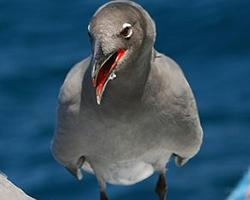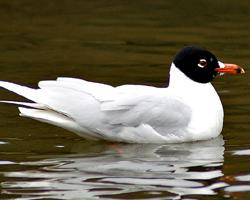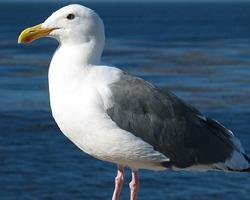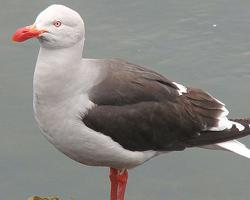
Stav ohrožení
| Ohrožen |
Popis zvířete
The Lava Gull, scientifically known as Leucophaeus fuliginosus, is a unique and fascinating bird species endemic to the Galapagos Islands. This rare bird is the smallest member of the gull family found in this archipelago and is considered one of the rarest gull species in the world, with an estimated population of fewer than a thousand breeding pairs. Its exclusive presence in the Galapagos Islands and limited population size have led to its classification as a vulnerable species.Characteristically, the Lava Gull exhibits a striking plumage that is predominantly slate-grey, which provides an effective camouflage against the volcanic rocks of its natural habitat. This adaptive coloration allows it to blend seamlessly with the environment, making it a master of stealth. The adult Lava Gull is distinguished by its dark, sooty-grey feathers that cover most of its body, contrasted by a lighter grey on its head. Its underparts are slightly paler, providing a subtle but noticeable contrast.
One of the most distinctive features of the Lava Gull is its intense, red-rimmed eyes, which are set against a stark, white eye-ring. This striking eye coloration is complemented by a robust, black bill and equally dark legs, adding to its distinctive appearance. The bird's wings are broad and powerful, featuring a white leading edge that becomes visible during flight, creating a beautiful contrast with the darker shades of its body.
The Lava Gull leads a predominantly solitary life, except during the breeding season when pairs come together to raise their young. They are known for their territorial behavior, often aggressively defending their nesting sites from intruders. Their nests are typically constructed on the ground, using vegetation and debris, and are strategically placed in sheltered locations to protect them from predators and the elements.
Diet-wise, the Lava Gull is an opportunistic feeder, relying on a varied diet that includes fish, insects, and other small animals. They are also known to scavenge, taking advantage of food sources provided by human activity or the leftovers from other predators. This adaptability in feeding habits has allowed them to thrive in the harsh and fluctuating environment of the Galapagos Islands.
The vocalizations of the Lava Gull are as distinctive as their appearance, characterized by a range of harsh, grating calls that are used for communication between individuals, especially during the breeding season. These calls play a crucial role in mate attraction and the establishment of territorial boundaries.
Conservation efforts for the Lava Gull are ongoing, with a focus on protecting their natural habitat and reducing human-induced threats. The Galapagos National Park and various conservation organizations are actively involved in monitoring the population and implementing measures to ensure the survival of this unique species. Despite these efforts, the Lava Gull remains vulnerable due to its limited range and the ongoing challenges posed by environmental changes and human activities.
In conclusion, the Lava Gull (Leucophaeus fuliginosus) is a remarkable bird species that embodies the unique biodiversity of the Galapagos Islands. Its distinctive appearance, adaptive behaviors, and rarity make it a subject of great interest and concern for conservationists. The ongoing efforts to protect and preserve the Lava Gull are vital for ensuring that this exceptional species continues to thrive in its natural habitat for generations to come.
Podobná zvířata
Nové fotografie zvířat
Top 10 zvířat
- Chinese water dragon (Physignathus cocincinus)
- Galápagos tortoise (Geochelone nigra complex)
- Dolphin gull (Leucophaeus scoresbii)
- Japanese macaque (Macaca fuscata)
- Colombian red howler (Alouatta seniculus)
- Sea urchins (Echinoidea)
- Diana monkey (Cercopithecus diana)
- Moustached guenon (Cercopithecus cephus)
- Colossal squid (Mesonychoteuthis hamiltoni)
- Common house mosquito (Culex pipiens)


